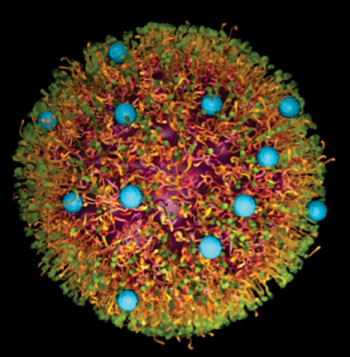Multispectral Optoacoustic Tomography and siRNA Molecules Used as Nano-Guides to the Liver
By MedImaging International staff writers
Posted on 30 Dec 2014
Highly specific nanoparticles have been developed that, depending on the bound dye, are guided to the liver or to the kidney and designed to deliver their cargo of active ingredients directly to the targeted tissue. Posted on 30 Dec 2014
The reduction of cholesterol production induced by small interfering RNA-molecule (siRNA) served as the proof-of-principle for the developed technology. The scientists have been successful in generating very specific nanoparticles. Depending on the bound dye the particles are guided to the liver or to the kidney and deliver their cargo of active substances directly to the targeted tissue. Moreover, the dyes enable the monitoring of the transport processes by intravital microscopy or, in a noninvasive way, by multispectral optoacoustic tomography. The reduction of cholesterol production triggered by siRNA served as the proof-of-principle for the developed method. The scientists, from Friedrich Schiller University Jena (Germany), reported their data December 3, 2014, in the scientific journal Nature Communications.

Image: Scheme of a nanoparticle loaded with drug in the core (purple) and specific dye marker at the surface of the particle (blue dots) (Photo courtesy of JCSM/SmartDyeLivery, GmbH).
This new technology is one of the great hopes for target-oriented treatment approaches: the so-called siRNA. These are able to silent specific genes, by preventing them from generating proteins that are encoded on them. To accomplish this, the siRNA has to be delivered specifically into the targeted cells to perform only there and nowhere else. Moreover, the siRNA should not be just excreted or, even worse, damage healthy tissue. This is what makes the management of siRNA extremely difficult. Physicians and chemists from Jena and Munich (Germany) and the United States have now succeeded in creating nanotransporters for this genetic material, which are able to specifically and effectively target selected cell types and release their active payload there.
The particles which are based on polymers are marked with near infrared fluorescent dyes and loaded with siRNA. The dyes work similar to address labels and tracking numbers for the particles all in one. “Depending on the chemical structure of the dye the particles are filtered out of the blood either via the kidney tissue or via liver cells. At the same time, this route can easily be tracked by optical methods with the aid of the dyes,” stated intensive care physician Prof. Dr. Michael Bauer. His research team at the Jena University Hospital Centre for Sepsis Control and Care (CSCC) was also able to demonstrate that the dye is specifically absorbed by a specific cellular transporter of the liver epithelial cells and taken up into the cells.
In this manner, the siRNA load is exclusively released in the target cells. The specifically functionalized nanocontainers have been designed and produced in the laboratories of the Jena Center for Soft Matter (JCSM) of the Friedrich Schiller University in Jena. “This method can be regarded as a kind of toolbox for a multitude of different siRNA-nanotransporters which can ensure the targeted, switch-off of specific protein biosynthesis in different cell types,” stated the director of the JCSM, Prof. Dr. Ulrich S. Schubert.
With the possibility to test the non-coupled dyes in advance and to switch off genes, which are associated with illnesses, the principle offers new approaches to a personalized therapy of various diseases. In the newly founded SmartDyeLivery, GmbH, the scientists want to further develop the technology to use it in the clinical environment, particularly in cases of acute septic infections.
The nanomedicine researchers clarified in their study the working basis of their toolbox using the example of cholesterol production. They loaded the nanoparticles with targeting dyes attached with siRNA-molecules. The siRNA molecules interfered with cholesterol production in hepatocytes, which resulted in a distinct reduction in the cholesterol level in the blood of test animals.
Related Links:
Friedrich Schiller University Jena














